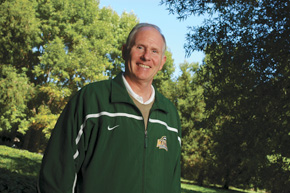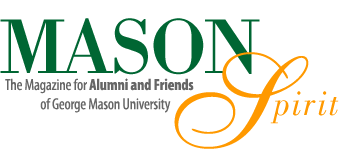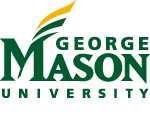The Tao of Coach L
How did Jim Larranaga turn Mason’s men’s
basketball program into a hoops juggernaut?
By placing zero emphasis on winning.
By Ken Budd, BA English ’88,
MA English ’97
The white notebook sits on a tall bookshelf in head coach Jim Larranaga’s office. It’s 108 pages long: the encyclopedic Jim Larranaga philosophy of success, circa 1988. In his early years at Bowling Green State University, still struggling to find his way as a coach, he showed the thick notebook to Dick Bennett, then the head man at Wisconsin-Green Bay, later a Final Four coach at the University of Wisconsin. Bennett studied it and gave him some advice: “It’s 107 pages too long.”
One page, said Bennett. Get your philosophy to one page—then you’ll have what you want.
It took Larranaga two years to refine his philosophy. When he brought it to Fairfax in 1997, it helped spur the most successful run in school history: five postseason appearances, eight straight winning seasons, and—you may have heard—a trip to the Final Four. Yet his philosophy is so simple it can be summed up in three words. Attitude, commitment, class. He wants everyone associated with the team to have a positive attitude. He also asks his players to make a physical, mental, emotional, and spiritual commitment to the team, their studies—everything—and to compete in a first-class manner.
“We rarely, if ever, talk about winning,” says Larranaga. “We think winning is a result of doing a lot of little things well. If you focus on winning you miss things in the process that are so darn important. And if you focus on the process, the winning will take care of itself.”
It’s a Buddha-meets-Stephen R. Covey approach that reflects a burgeoning interest in Eastern philosophy. He’s read several books on Zen Buddhism, and when he hits the treadmill he frequently listens to the audio version of Sacred Hoops, L.A. Lakers’ coach Phil Jackson’s Zen-influenced book on spirituality and teamwork. Larranaga’s players were recruited in part because they buy into the coach’s anti-Lombardi ideas—his visualization techniques (the team “imagined” a Final Four run before the season even started), his “thought of the day,” his quirky motivational techniques (remember “Kryptonite”?).
“A lot of people only evaluate physical talent,” he says. “We evaluate the whole person. Yes, basketball skills are important. But more importantly does he have a positive attitude, a good work ethic, is he team-oriented, is he a consistent performer.”
For the coach, talent never trumps character. Ahmad Dorsett, BS Health, Fitness, and Recreation Resources ’01, was a sophomore shooting guard when Larranaga was hired and remembers hosting a highly touted recruit who was visiting campus. “He could have been the conference player of the year, but his attitude stank,” says Dorsett, now the head boy’s basketball coach at Freedom High School in Woodbridge, Va. “Coach asked us: ‘What do you think?’ We said, ‘He’s not a good fit—he’s got a bad attitude.’ Coach L sent him home the next day, which showed a huge amount of confidence in his players. The coaches didn’t make the decision to pass on this guy; the players did.”
Larranaga sees himself as both mentor and educator to his players, inviting them to his home and taking them to museums in Washington, D.C., over Christmas break.
“We function like a family, meaning we love each other, we hang out together. If you want to be a part of that,” he tells recruits, “then George Mason might be the right place for you. But if you put yourself first and see us as a stepping stone to the pros, we’re probably not the right program.”
The program was anything but right when he was hired. Mason had endured seven straight losing seasons, yet the coach embraced the returning players, giving them their first taste of Larranaga logic. “We asked them, ‘Do you want to be successful?’ And of course they said yes. And I said, ‘Let’s list the most successful college basketball programs in the country and see what they do right.’ And we listed Duke, North Carolina, Connecticut, Michigan St., Arizona, and we wrote down 27 things they do to be successful. Most of them were intangibles: hard work, sacrifice, dedication. I said, ‘OK, which of these can’t we do.’ They said, ‘Coach—we can do them all.’ ‘That’s exactly right,’ I said. And I told them, ‘If you’ll embrace my philosophy of life, I think we can get started right away.’”
By his second season, the Patriots were in the NCAA Tournament. Eight years and 180 wins later, Larranaga’s philosophy has been both tested and validated. Through unexpected challenges and soaring Final Four highs, he remains the same man, grounded by the same philosophy of life.
“We like to win,” says Larranaga. “But winning is never the most important thing.”

The Fab Five
Yes, Jim Larranaga is the towering titan of Mason hoops history. And with apologies to such Mason greats as Robert Dykes, Andre Gaddy, and Ricky Wilson, here are five figures whose names or numbers should hang from the rafters of the Patriot Center.
1
Carlos Yates
1981–85
Yates is the all-time school leader in total points scored, and he did it before the NCAA adopted the three-point shot.
2
George Evans
1997–2001
This three-time CAA Player of the Year and two-time Defensive Player of the Year led Mason to conference championships in 1999 and 2001.
3
Kenny Sanders
1986–89
An inside force despite being undersize at 6'5", Sanders was CAA Rookie of the Year in 1986 and Player of the Year in 1988, and led Mason to its first NCAA tournament game in 1989.
4
Joe Harrington
1980–87
He won 112 games in seven seasons as head coach, guiding Mason to its first two 20-win seasons and first-ever postseason win in the 1986 National Invitational Tournament.
5
Lamar Butler, Jai Lewis, and Tony Skinn
2001–06
Okay, we’re cheating here, but it’s hard not to think of these guys as a single entity in leading Mason to the 2006 Final Four.
—Ken Budd

